Lineups, flight delays, lost luggage – here’s how to handle whatever comes your way, on the ground and in the air, so you can enjoy your trip.
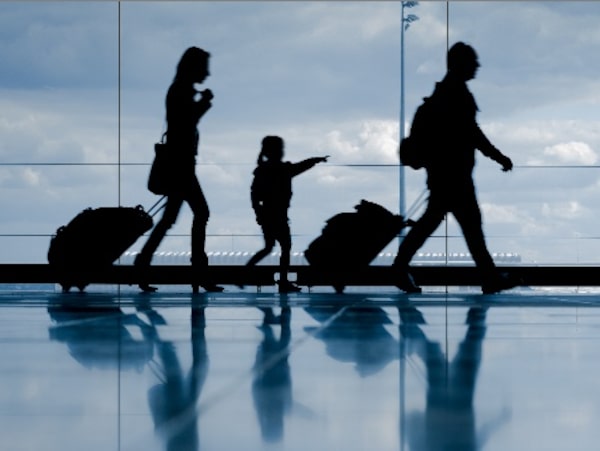
NICOELNINO/GETTY IMAGES/ISTOCKPHOTO
How not to behave at the airport
- Take your time: The airport is not the place to go for a leisurely stroll, especially postsecurity. You might have a four-hour layover but that person running up behind you sure doesn’t. Move briskly or keep the way clear for others; no walking four abreast, holding hands (except a child’s) or randomly stopping in a high-traffic area to rummage through your bag. Also, remember that not everyone wants to simply stand on the moving walkway.
- Make it all about you: Something went wrong? Remember that you’re likely not the only one affected. If a flight is cancelled that means hundreds of people need to be rebooked and, in most cases, you are no more important than anyone else. Don’t take your frustrations out on the person behind the desk when it is not their fault.
- Swarm the gate: The term “gate lice” refers to the hordes of passengers who crowd the gate before their boarding zone is called. Do you want to be an annoying pest? I get it: You desire overhead bin space for your carry-on. But until there is a better system, chill and stay clear. Most airlines have – rightly – started sending would-be queue jumpers to the back of the line. Follow the rules and everyone will board faster.
- Be a power hog: While some airports have clued in that power outlets are more important to certain travellers than food, spots to charge devices are still few and awkwardly placed in many terminals. If you see people eyeing your plugged-in devices with envy, power up enough to get by and then let someone else have a turn. Or, even better, carry a multi-USB hub with you and be the airport hero.
- Waste everyone’s time: Don’t be the fumbling passenger at security who wastes everyone’s time. Be ready. Empty your water bottle. Show your passport and boarding pass to get into the line, and show the pass again to the screener. Put your laptop in a bin by itself. Take off your jacket and any similar layers. Remove everything from your pockets.
– Domini Clark
How to help yourself, and others, at airport security
- Choose the right line: If you can, get behind as many solo adults as possible. Business travellers know what they’re doing and will keep the line moving quickly. Families and first-time holidaymakers (such as that honeymooning couple who are only paying attention to each other) are going to slow things way down.
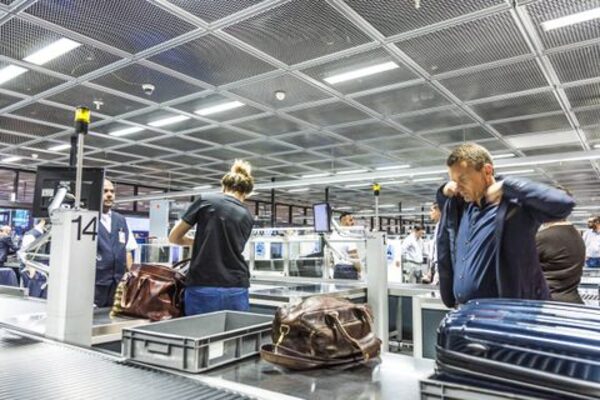
MEINZAHN/GETTY IMAGES
- Get organized: The screening agent wants to see one thing: your boarding pass. So put your ID away and have your pass in your hand as you approach. If it’s on your phone, have the screen up and ready to go. And forget about using your smart watches: It’s awkward, if not impossible, to fit your wrist under the scanner.
- Prep in line: Take your jacket off, along with any cardigans and zip-up/button-up sweaters and drape them over your luggage or arm. If you know you’re going to have to take your shoes off, consider undoing the laces in advance (just tuck them in your shoes/boots so you don’t trip on them).
- Upgrade your gear: Remember that laptops must be taken out of any bags and placed in a separate bin. If you frequently travel with a computer consider getting a bag with an exterior laptop pocket. This makes it easier to take the device out but, even better, makes it a cinch to slide it back in.
- Power up: If you get selected for secondary screening, you might have to turn on your electronic devices (yes, this still happens). So make sure they’re charged before you get to the airport. Failing that, you better hope you didn’t check your power cord.
– Domini Clark
How to get through security faster over the Christmas holidays
- Keep presents unwrapped: This is one of the main rules the Canadian Air Transport Security Authority (CATSA) wants travellers to follow this time of year. If items have to be inspected, you don’t want your expert ribbon work going to waste.
- Have electronics handy: Laptops must be removed from carry-on baggage, but any jumble of electronics and wires can trigger a secondary inspection, so make sure video games, chargers and the like are easily accessible. (And remember, no lithium batteries in your checked bags.)
- Watch your liquids: Packing edible gifts? Remember that non-solid food counts toward your liquid allowance. So jams, jellies, nut butters, syrups and spreads must be in bottles no larger than 100 millilitres each, and all liquids must fit into a clear one-litre bag.
- Be prepared: Outerwear has to come off, so CATSA suggests making sure children are sporting easy-to-remove winter jackets and hats. Don’t be the person who holds up the line over a finicky zipper.
- Learn the rules: As of last year, blades of up to six centimetres are permitted as carry-on luggage on domestic flights. Also, powders – such as bath salts, sand and other inorganic materials – are now allowed (up to 350 ml). For more information visit catsa.gc.ca.
– Domini Clark
What to do if your flight is cancelled
- Keep calm and carry on: Airlines typically rebook you on the next available flight automatically. You can either ask for a full refund – which can be done through the website or hotline – or stick with the new itinerary (which might only mean a few hours delay). Avoid running to the queue immediately; it’s not worth the experience of being sandwiched among dozens of disgruntled passengers.
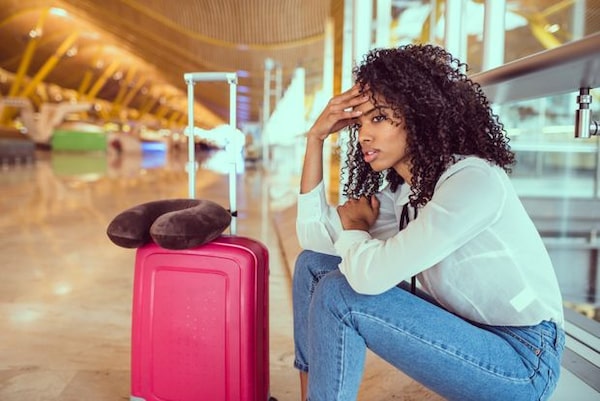
DAVID-PRADO
- Call customer service: Airport staff are often “harassed by too many people, under a lot of pressure, and can only give you a certain amount of limited time to find a solution for you,” says Arif Khan, manager of Voyages Norko Travel in Montreal. Call customer service instead, where an agent can talk you through all the options.
- See what’s available: It is not uncommon for airlines to fly in an empty plane and rebook all passengers on it. Depending on your final destination, it might not get you there in the shortest amount of time. “You must remind them to look for partner airlines too; sometimes they only look in their system for the airline,” Khan added.
- Ask, ask ask! “Be proactive and ask politely,” says Andrew D’Amours, co-founder of Flytrippers, a website that offers flight deals and advice. Food and hotel vouchers are usually offered for passengers stuck overnight, but airline staff might overlook these details when they’re under a lot of pressure. Also, having the ground staff on your side might land you a seat with extra legroom or lounge access.
- Express your grievances: After you’ve unpacked from your trip, tell the airline how your plans were disrupted. Unless your flight was cancelled due to reasons out of the airline’s control, namely bad weather, you might get a voucher or even cash compensation (if your flight began or ended in an EU country). Remember: A happy customer is a returning customer. Play that to your advantage!
– William Pang
What to do if you miss your connecting flight
- Avoid the line (if you can): While a herd mentality is common in these situations – everyone rushing to the re-booking desk, jockeying to get to the front of the line – you may have better options. If you have status with the airline or hold a higher-end travel credit card, you’ll have a reserved number to call in cases like this. Instead of queuing up, take a deep breath, find a quiet corner and make the call.
- Be nice and ask for the person in charge: If you think you’ve had a long day, the rebooking agent, dealing with an endless succession of surly and panicked passengers, has surely had a longer one – a simple kind word can sometimes get you on a better flight (or at least into a nicer seat). And if you’re not getting what you need, ask to speak with the supervisor or even station chief, who have greater authority to override restrictions and more flexibility to book off-limits routes (and make upgrades).
- Use social media: Nobody likes bad press, including airlines. Even if you don’t have a huge following, a tweet or public Facebook message can see immediate results. “Anytime I’ve a missed a flight, I found tweeting got me instant contact with ‘powers that be,’ ” veteran travel writer Sue Campbell says. “They respond with a direct message and try to help – 10 times faster than calling or even talking to gate agents.”
- Buy the insurance: There are also things you can do before the fact to make a missed connection less painful. It seems almost antithetical in our age of rock-bottom fares, but it can pay to spend a little extra and buy trip cancellation insurance. “It doesn’t cost much and when something happens, you can make decisions quicker and easier knowing that you have insurance to cover those costs,” says Charlotte April Harris, head of sales and marketing for Hong Kong-based Charlotte Travel.
- Use a travel agent: Booking yourself online can be easy and cheap, but it won’t get you to the front of the line faster. “We have direct, exclusive phone numbers and contacts with the airlines,” says Darren Prashad, a manager at Merit Travel in Ottawa. “My parents got bumped once and I had them rebooked before they made it through to the airline counter.”
– Tim Johnson
Things you should never do on a plane
- Hog the overhead bin: Thanks to checked-baggage fees, space for carry-on luggage is at a premium. Which means that, sorry, no, your jacket doesn’t get its own little area up there. Neither does your tiny purse. Nor your baseball cap. You do realize your selfishness is delaying takeoff because you’ve forced other people to spend time moving things around, right? Keep smaller items on you, and if there is room after everyone has boarded, then go ahead and stuff them in. Otherwise, under the seat they go.
Joe Sacher/Getty Images/iStockphoto
- Create noise pollution: Do not make people listen to whatever it is you’re doing on your electronic device. It doesn’t matter how low you have the volume: No one wants to spend three hours listening to random movie dialogue or the dings of a video game. Unfortunately this crime against fellow travellers is on the rise as more airlines switch to entertainment apps that require passengers to use their own devices. If you forgot your headphones, learn from your mistake and buy a pair from the flight attendant.
- Be gross: This covers a range of acts, including but not limited to: going barefoot (and, even worse, going barefoot to the bathroom), stuffing used banana peels and apple cores in the seatback pocket, cleaning out your ear wax while sitting next to a stranger, chewing with your mouth open and clipping your nails. (If you’re reading this thinking, “Oh come on, people don’t do those things,” then you are wrong, my friend. Dead wrong).
- Disrespect the book: Listen, I get it: You’re a nervous flyer and need some reassurance. Or you’re a mom longing to talk to a sane adult after a week on a Disney cruise with your family. You still need to take the hint: If the desired target of your banter is reading a book – or, more blatantly, has headphones on – he or she doesn’t want to chit-chat. With anyone. It’s not personal, really.
- Sing out loud: You would think some things wouldn’t need to be said. Yet on a recent flight to New York the lady across the aisle from me spent much of the flight performing in her own one-woman karaoke bar, singing along to the music playing in her headphones. The fact that I had my laptop out and was clearly trying to work made this even more irritating. Unless people regularly pay big bucks to hear you perform, keep that urge to belt it out bottled up.
– Domini Clark
How to make any flight more comfortable
- Do your research: Before you select your seat, punch your flight info into seatguru.com. For no fee, you’ll find out which seats have the most leg room and recline, will squish you with a reduced width and are closest to the washrooms. Not all premium seats are created equal even on the same flight; if you’re going to pay an extra fee, make sure you get your money’s worth.
- Party in the back: It’s still a contentious issue, but the majority of flyers seem to be in agreement that reclining your seat on most flights is not cool. (An exception is overnight flights when everyone is doing it and trying to sleep.) If you must do it, try booking a seat in the last row: With no one behind you, you can lean back guilt-free. Just use SeatGuru first; some back rows have limited, if any, recline.
- Stick to the outside: Some people swear by window seats, but there is a strong case to be made for taking the aisle spot. You lose the view, yes. What you gain is the ability to easily get up whenever you want to take a walk, stretch, visit the washroom or wander to the galley to discreetly ask for extra pretzels. All of which make for a more comfortable experience.
- Know the equipment: On some planes there is a little lever at the back of the aisle armrest that lets you raise it for some extra wiggle room. (Just mind your elbows during the food and beverage service.) And in case you never noticed, those headsets are typically adjustable: Bend the sides to wrap around your head so you don’t fall asleep on your neighbour’s shoulder. Leave the bulky neck pillow at home.
- Ditch your shoes: Sitting with shoes on as your feet swell in the air isn’t fun. Nor is wearing heavy boots on a warm flight in winter. So go ahead and take them off – with one major caveat: You must have a pair of clean airplane socks to put your feet in. If you want to go the compression route, Soxxy makes cute ones. And, please, put your shoes back on before heading to the toilet.
– Domini Clark
How to avoid getting sick on a plane
- Get a window seat: Window seats are most advantageous, “just because they don’t have as much contact with other individuals,” says Vicki Stover Hertzberg of Emory University, the lead researcher on a new study looking at the spread of respiratory diseases during transcontinental flights.
- Don’t stress too much: “We found that around a person who is infectious, it’s only the row ahead of that person, the row behind, and two seats to either side that are most at risk of infection from that individual … in other words, don’t worry about the person five rows behind you coughing their heads off.”
- Stay put: Unless you have medical reasons requiring you to stretch your legs during a flight, stay put, minimizing your contact with others. “To be on the cautionary side – and optimize your chances of not getting sick – try to stay in that window seat and don’t get up.”
- Keep your hands clean: Observing healthy hand hygiene is a must, as is keeping your hands away from your face. “Your hands are going to pick up some stuff, either by people sneezing, or what’s in the air getting on them. … [If] you put your hands on your face, you could transfer that to the mucus areas of your eyes, nose or mouth. That’s how the germs – the microbes – enter the body.”
- Wipe the tray table: A 2015 study by TravelMath revealed that seat tables were covered in more than eight times the amount of bacteria per square inch than the airplane’s toilet flush button. (It’s not unheard of for people to change an infant’s diaper on them.) Carry a pack of disinfectant wipes and give it – and the armrests and touchscreen if there is one – a good swab as soon as you sit down.
– Tara Henley
How to sleep better on a plane
- Pick the right seat: A window seat is the obvious choice for sleeping, and if it’s a smoother ride you seek, sit near the front of the plane. Then there’s the holy grail of airborne slumber: Sprawling across two or more empty seats. Flying at off-peak times may give you an edge. A riskier gambit involves selecting the middle seat when the seat map shows empty rows, as this may discourage others from booking on either side of you. You can typically check back to see whether the neighbouring seats get booked and change your selection if need be.
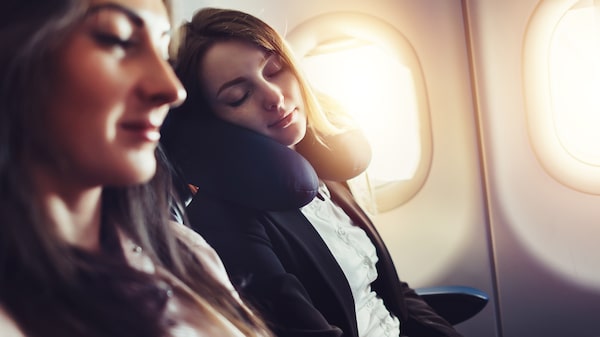
undrey
- Bring the right gear: Eye masks, ear plugs and neck pillows are essential sleep accessories. To take things to the next level, consider replacing the ear plugs with noise-cancelling headphones. And if the typical horseshoe-shaped neck pillow isn’t cutting it, try alternatives such as the scarf-like Trtl Pillow, the bendable Infinity Pillow or the inflatable AirComfy Ease Pillow.
- Dress for sleep success: If you’re uncomfortable with the idea of wearing pyjamas on a plane, go with the next best thing: Loose, comfortable clothing with full draft-defying coverage. Then again, with loungewear companies such as Sleeper aiming to popularize public displays of PJs, your fuzzy slippers may already be kosher in the stratosphere.
- Be ready to snooze: Sleeping before the cabin service ends can be especially challenging, so you might as well use this time to your advantage. Visit the washroom, have something to eat and drink – no caffeine or alcohol, and not too much food – and get as comfortable as possible by adjusting your air vent and deploying a blanket with your seatbelt buckled over top. (That way, the cabin crew can see the belt and won’t wake you if it needs to be secured.) Then, when the lights go down, you’re ready to drift off ASAP.
- Say no to screens: As tempting as it may be to catch up on work or watch a movie during the cabin service, the light emitted by laptops, smartphones, tablets and seatback screens suppresses the release of the sleep-inducing hormone melatonin and makes it harder to doze off. As an alternative, grab an in-flight magazine and look for a story on counting sheep or watching paint dry.
– Adam Bisby
How to look good getting off a plane
- Guzzle the H2O: Sometimes you need to impress right after a long flight touches down: You’re headed to a meeting perhaps, or maybe a long-distance love is waiting on the other end. The No. 1 for not looking like the exhausted traveller you are: drink water. A lot of water. Experts recommend eight ounces for every hour you’re in the air.
- Feed your skin: If you don’t stay hydrated, it’s going to show on your skin. My secret: I start my offensive preboarding by heading to the duty-free and “sampling” the richest facial moisturizer I can find. Some jet-setters swear by indulging in a full sheet mask during flight, but if that’s too embarrassing, go for one that covers just the eye area and hide it with a sleep mask.
- Dress the part: If you can manage it, keep a second outfit handy for a quick change at the first airport bathroom you see. In any case, look for wrinkle-free fabrics such as wool, knits and Tencel. High-quality skirts and dresses in polyester travel like a dream. And, in most situations, it’s hard to go wrong with dark denim, a simple shirt and a smart blazer (ask a flight attendant to hang it, or fold and lay flat in the overhead bin after all luggage has been placed).
- Wake yourself up: If you’re not in the right mindset, doing all of the above will only help you so much. You need to get past the drudgery and find a place of excitement. Find what works for you. Listen to favourite songs, have a coffee before landing, sprint to customs control – whatever gets your endorphins flowing and blood pumping.
- Wear sunglasses: If all else fails, this is your best option. There is a reason celebrities always wear sunglasses while walking through the arrivals area: It’s the easiest way to hide a multitude of eye-related unpleasantness: bags, dark circles and bloodshot whites. If you’re plunging right into sightseeing, just leave them on for pics.
– Domini Clark
How to recover from a long flight
- Put your legs up: Sitting for long periods can cause fluid buildup in your legs, which can lead to muscle soreness and even blood clots. As soon as you reach your destination, lie down on the bed or floor and prop your legs up on the wall or headboard for 15 minutes. It will drain the fluid and reduce swelling.
- Hit the gym: You might feel completely ravaged when you land, but the best way to get some energy back and your blood flowing again is to exercise. If you’re not a big gym person, go for a run or a brisk walk around your destination. It will also help feed oxygen to your brain and muscles after spending hours in the oxygen-reduced environs of the plane.
- Stay awake until a regular time: Perhaps your first thought after spending 10 hours sitting upright and listening to crying babies is to catch up on all that lost sleep. But that post-flight nap won’t allow your body to adjust to your new time zone and will leave you feeling jet-lagged. Power through and stay awake until your usual bedtime; you’ll barely notice you’re half a day ahead.
- Cleanse with some saline solution: The dry air and circulating germs on an airplane can leave you susceptible to nasty colds. Flushing your nose out with saline solution after a flight clears your nasal passages of dust and germs, decreasing your chances of getting sick.
- Carbo load: High carbohydrate intake leads to higher levels of insulin, which help your body adjust to a new eating and resting schedule. Don’t stress out too much about the calories; it’s just one day. And having lots of starches in your system makes the transition to a new destination a whole lot easier.
– Matt Meltzer
What to do when your luggage is lost
- Write an inventory of what’s in your bag: “Each bag tag has a unique bar code. Ideally each bag is scanned at every point along the journey,” says Adrian Lee, a ticket agent who retired recently after working at Los Angeles International Airport for 17 years. “But the worst case scenario is when a tag comes off of a bag. It doesn’t happen often, when it does we call it a ‘tag off.’ ” When that happens, airline agents enter a list of items in your bag, in the hopes it matches with another entry in the airline’s database.
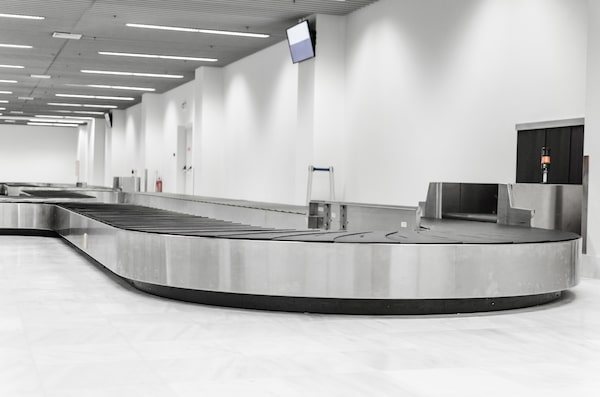
iStock/iStock
- Get your cash up front: In addition to an amenity bag filled with the basics (toothbrush, comb), airlines are authorized to dole out a preset amount of money, so you can buy items you’ll need immediately, such as underwear. Passengers are typically asked to keep receipts and submit them later for reimbursement, but you’re better off getting the cash up front, in case you lose the paperwork (or forget to send it in).
- Know your rights: Certain regions of the world have legally mandated bills of rights for passengers. For example: If you’re flying within or from the European Union, on an EU airline, you can claim compensation of up to €1,220 for lost luggage.
- Ask for the max: Airline agents often have some leeway in how much money they disburse in the case of a delayed bag, so approach that conversation as a bargaining situation. Travel writer Gayle Keck remembers landing in Tokyo without her bag. “I was flying in from steamy Thailand, so was dressed for the tropics, but it turned out that they had a stash of Uniqlo lightweight down jackets and gave me one. I never would have gotten it, without being persistent.”
- Download the airline’s app: A number of airlines provide helpful baggage info on their apps – Delta, for example, provides real-time updates on your bag’s location and Lufthansa will provide a digital copy of your baggage tag.
– Tim Johnson



